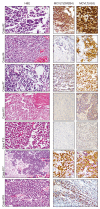Merkel cell polyomavirus is implicated in a subset of Merkel cell carcinomas, in the Indian subcontinent
- PMID: 31600537
- PMCID: PMC7166130
- DOI: 10.1016/j.micpath.2019.103778
Merkel cell polyomavirus is implicated in a subset of Merkel cell carcinomas, in the Indian subcontinent
Abstract
Merkel cell carcinoma is a rare, lethal cancer histopathologically composed of cells showing similarity with mechanoreceptor Merkel cells. Merkel cell tumors manifest in two distinct forms. While a virus called Merkel cell polyomavirus is involved in the pathogenesis of one form of Merkel tumors, the other is driven by ultraviolet (UV)-linked mutations. In this study we investigated 18 cases, from the Indian population, of Merkel cell carcinoma for immunohistochemical (IHC) expression of Merkel cell polyomavirus (MCV) T antigen, including 12 cases tested by PCR, to identify viral etiopathology. We tested the tumors with two sensitive antibodies (CM2B4 and Ab3), targeting the viral large T antigen protein and with PCR primers targeting the N terminus of T antigen. Overall, we observed 38.8% (7/18) tumors displaying positive IHC expression of Merkel cell polyomavirus T antigen and 25% (3/12) tumors showing positive results, by both, immunohistochemistry and PCR. This constitutes the first report from India showing implication of MCV in Merkel cell carcinomas. Moreover, this is one of the larger series of Merkel cell carcinomas, tested for MCV, by both immunohistochemistry and PCR, in this part of the world. These results further indicate that a slightly more number of such cases in India are likely to be caused by UV-linked damage, as opposed to Merkel cell polyomavirus mediated tumorigenesis, which is definitely implicated in a subset of cases.
Keywords: MCC; MCV; Merkel cell carcinoma; Polyomavirus; T antigen.
Copyright © 2019 The Authors. Published by Elsevier Ltd.. All rights reserved.
Conflict of interest statement
The authors declare no conflict of competing interests related to this work.
Figures

Similar articles
-
Improved detection suggests all Merkel cell carcinomas harbor Merkel polyomavirus.J Clin Invest. 2012 Dec;122(12):4645-53. doi: 10.1172/JCI64116. Epub 2012 Nov 1. J Clin Invest. 2012. PMID: 23114601 Free PMC article.
-
The spectrum of Merkel cell polyomavirus expression in Merkel cell carcinoma, in a variety of cutaneous neoplasms, and in neuroendocrine carcinomas from different anatomical sites.Hum Pathol. 2012 Apr;43(4):557-66. doi: 10.1016/j.humpath.2011.06.005. Epub 2011 Sep 21. Hum Pathol. 2012. PMID: 21940035
-
High-affinity Rb binding, p53 inhibition, subcellular localization, and transformation by wild-type or tumor-derived shortened Merkel cell polyomavirus large T antigens.J Virol. 2014 Mar;88(6):3144-60. doi: 10.1128/JVI.02916-13. Epub 2013 Dec 26. J Virol. 2014. PMID: 24371076 Free PMC article.
-
Merkel cell polyomavirus: a newly discovered human virus with oncogenic potential.Virology. 2013 Jan 5;435(1):118-30. doi: 10.1016/j.virol.2012.09.029. Virology. 2013. PMID: 23217622 Free PMC article. Review.
-
Merkel cell polyomavirus and non-Merkel cell carcinomas: guilty or circumstantial evidence?APMIS. 2020 Feb;128(2):104-120. doi: 10.1111/apm.13019. Epub 2020 Jan 28. APMIS. 2020. PMID: 31990105 Review.
Cited by
-
DETECTing Merkel Cell Polyomavirus in Merkel Tumors.Front Mol Biosci. 2020 Feb 4;7:10. doi: 10.3389/fmolb.2020.00010. eCollection 2020. Front Mol Biosci. 2020. PMID: 32118036 Free PMC article.
-
Evaluating CK20 and MCPyV Antibody Clones in Diagnosing Merkel Cell Carcinoma.Endocr Pathol. 2025 Jan 22;36(1):1. doi: 10.1007/s12022-024-09845-w. Endocr Pathol. 2025. PMID: 39841326 Free PMC article.
References
-
- Hodgson NC. Merkel cell carcinoma: changing incidence trends. J Surg Oncol. 2005;89:1–4. - PubMed
-
- Schadendorf D, Lebbe C, Zur Hausen A, Avril MF, Hariharan S, Bharmal M, et al. Merkel cell carcinoma: epidemiology, prognosis, therapy and unmet medical needs. Eur J Cancer. 2017;71:53–69. - PubMed
-
- Lemos B, Nghiem P. Merkel cell carcinoma: more deaths but still no pathway to blame. J Investig Dermatol. 2007;127:2100–2103. - PubMed
MeSH terms
Substances
Grants and funding
LinkOut - more resources
Full Text Sources
Research Materials

